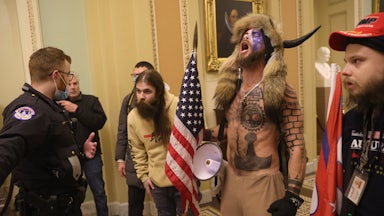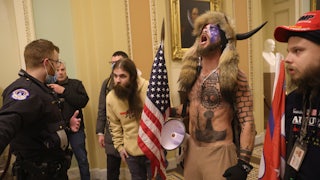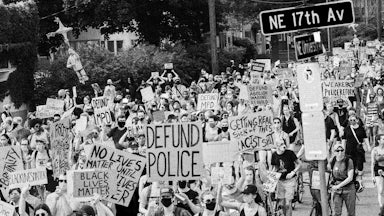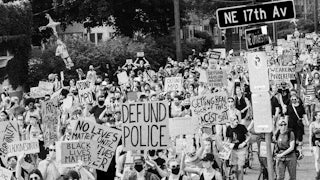In 1811, between 200 and 500 enslaved Black people armed themselves in a revolt that began on a sugar plantation a few miles outside of New Orleans. Charles Deslondes, a slave driver of Haitian descent, marshaled an insurrection against the slaver Manuel Andry, turning the tools of the plantation—the ax, the sugarcane knife—against his master. “An attempt was made to assassinate me by the stroke of an axe, and my poor son has been ferociously murdered,” Andry wrote of the attack in a letter to William C.C. Claiborne, then governor of Louisiana.
Once off the plantation, Deslondes and his cohort marched toward the city, where they sought to declare an independent republic. Looting, burning plantation houses, and recruiting other enslaved people on the way, the insurrection that began at Andry’s plantation grew its numbers and eventually arrived in New Orleans, where it faced federal troops and a local white militia. Deslondes and his fellow insurrectionists, outnumbered and outgunned, were met with brutal, lethal force and a subsequent sham trial. Still, news of the rebellion traveled anxiously through white newspapers, and their legacy endured. “The revolt had been much larger—and come much closer to succeeding—than the planters and American officials let on,” according to Daniel Rasmussen, author of American Risings: When Slaves Attacked New Orleans. “The slave army posed an existential threat to white control over the city of New Orleans.”
Two decades later, in 1831, a similar existential threat emerged and was again met with overwhelming state violence: The rebellion led by Nat Turner in Virginia was violently put down after President Andrew Jackson used the Insurrection Act, at the request of Norfolk’s mayor, to send three army artillery companies to suppress the uprising. (That same law, which allows the president to authorize use of military force against citizens, is the weapon Trump threatened to use against Black Lives Matter protesters last summer. It also may not come as a surprise that Trump had a portrait of Jackson hanging in the Oval Office.) Despite the brutal response, the insurrection forced Virginia to critically examine the institution of slavery, nearly leading to its end in the state. Another insurrection decades later, this time launched at Harpers Ferry in West Virginia by a multiracial militia led by the abolitionist John Brown, is now regarded as a precursor to the Civil War.
Throughout the period of chattel slavery, there were 250 recorded rebellions that took place before the Thirteenth Amendment was passed. For generations, Black insurrectionists have worked to overthrow the anti-Black system of racial and economic exploitation in the United States. From slave rebellions to the unrest sparked by the murder of George Floyd, American history is a history of Black insurrection.
This radical tradition has felt lost, or flattened into false equivalence with reactionary violence, in the wake of the Capitol riot, as a strange political coalition has come together to respond to what transpired on January 6—a chaotic assemblage of police officers, veterans, small business owners, QAnon yoga moms, current and former elected officials, and other Trump loyalists. The primary narrative that has emerged is one of overwhelming nationalism, not unlike what transpired after September 11. Trump is cast as treasonous while Democrats and a handful of opportunistic Republicans clear a path to reclaim the greatness of the country after four years during which resistance to the federal government was a fashionable position. We must consider what this sweeping condemnation of “insurrection”—and turn toward unquestioning patriotism—might mean for Black people, for whom insurrectionary acts and rebellion have been part of our pursuit of true freedom for more than 400 years.
Although slavery technically ended in 1865, the Jim Crow era meant that despite a freedom defined under the Constitution, Black people were still forced to fight for basic civil rights and freedom from violence. It would take a century for that particular apartheid regime to fall in another bout of national Black rebellion. Faced with the radicalism of the civil rights movement, President Lyndon B. Johnson would use the Insurrection Act against several Black uprisings: the Detroit Riots of 1967 and, following the assassination of Dr. Martin Luther King Jr., the uprisings in Washington, D.C., Baltimore, and Chicago in 1968.
In D.C. that year, the riots lasted four days, amounting to hundreds of millions of dollars in destruction in today’s dollars. A local publication reported in an anniversary series of the riot that Johnson, “could reportedly smell the smoke in the Oval Office.” In the 1969 book Ten Blocks From the White House, former Washington Post reporter Ben Gilbert interviewed some of the participants. In response to the question of violence, one replied: “We call it revolution—for freedom and liberation of Black people.”
During the rise of the era of mass incarceration, the site of insurrection also started to include prisons. In 1971, at Attica prison in New York, an uprising of mostly Black and Puerto Rican inmates overran the guards using pipes, chains, and baseball bats. They took hostages and demanded better conditions—The New York Times reported that prisoners were given only one roll of toilet paper a month and one shower a week—and amnesty for crimes committed during the riot.
Conditions worsened after prison guards and law enforcement took back control after four days of unrest. In 2000, a class action lawsuit filed in 1974 was settled on the behalf of more than 1,200 Attica survivors who said they were tortured as punishment for the uprising. Some prisoners were forced to crawl naked over broken glass and were denied medical treatment afterward, according to the Times. Larry Smith, one of the former inmates who spoke about their experience in court said, “When you explain to your kids and your grandkids what the whole essence of Attica was, you’ll be able to tell them that it was to be treated as human beings.’’
The most recent use of the Insurrection Act was under President George H.W. Bush. The year before, the nation watched as footage of four police officers beating Rodney King hit their television sets. After the officers were acquitted in 1992, Los Angeles was overtaken by five days of uprising. I remember watching it on TV as the city burned only a few miles from my house.
The media tried to paint the rebellion as nihilism, but as Raven Rakia wrote for The New Inquiry on the ways in which Black rebellions are viewed by non-Black America, “Looting is the opposite of apolitical; it is a direct redistribution of wealth. And yet, even on the left, when a black or African protester destroys and takes property, they are stripped of the tactical or historical will inherent in the decision.”
More than 20 years later, on August 9, 2014, officer Darren Wilson shot and killed Michael Brown. The militarization of American police forces meant that the response to the uprising in Ferguson, Missouri, resembled a military occupation. Despite curfews, clouds of tear gas, and crowd control munitions, the people of Ferguson and St. Louis stayed on the streets, awakening a new generation of Black insurrectionists. Deandre Smith, a Black barber who spoke to The Guardian about the unrest, said, “Mike Brown was the straw that broke the camel’s back.… That’s when we said this is enough. That’s it.” He added, “Plain and simple, this is the revolution. The one everybody was waiting on. It happened like this. By a people who want respect. African American people in this country.”
Following Ferguson, there were uprisings in Baltimore in 2015, after the shooting of Freddie Gray; in Baton Rouge, Louisiana, in 2016, after the killing of Alton Sterling; and in St. Paul that same year after the killing of Philando Castille. There were insurrectionary elements tied up in each of these events, in addition to more traditional aspects of Black reconciliation.
But it was the summer of 2020, after George Floyd was killed by a police officer with a knee on his neck, that set off the largest uprising we have seen in recent history. The murder would ignite a rebellion that demanded more than justice. Floyd was killed on May 25. By that Thursday, people had burned down Minneapolis’s third police precinct. The rebellion carried across the country: By the weekend, cop cars had burned in at least a dozen cities, as courthouses, municipal buildings, and retail stores also went up in flames. The language of abolition—including a demand to defund the police—soon forced its way into the mainstream. The desire was clear: Revolution, an end to the white supremacist capitalist state and the violent system that underpins all anti-Black social relations.
The tactics of these rebellions—from property destruction to demands for decarceration and abolition—were condemned by many elected officials and the political press. Former Attorney General Bill Barr, stoking a narrative of “outside agitation,” falsely claimed that the uprisings had been driven by people outside the communities in which they occurred, “many of whom travel from out of state to promote the violence.” Even former President Barack Obama criticized the “defund” demand of the uprisings.
But abolition—from the abolition of slavery imagined in the uprising of Charles Deslondes to the abolition of racial capitalism, violent policing, and the white supremacist state imagined in Detroit and Minneapolis a half-century apart—is at the heart of these insurrections. They were rebellions toward the realization of liberation—physical, mental, and social autonomy.
The objectives of the Capitol riot, insomuch as they were coherent, were to reverse the results of a democratic election in service of maintaining the Trump regime’s particular brand of nationalism and white supremacy. These are not the same things. In fact, one was a warning against the other. “The insurgencies of the Movement for Black Lives and its dozens of allied organizations have warned the country that unless we end racist state-sanctioned violence and the mass caging of Black and brown people,” the historian Robin D.G. Kelley wrote at the start of the Trump era, “we are headed for a fascist state.”
There has been very little engagement with this substance in the mainstream response to the violence at the Capitol. What has followed instead has been blanket condemnations of insurrection, a patriotic posture—shared by Democrats and Republicans—that holds the American state as a stable force for good. In his address to the nation responding to the Trump loyalists’ attack, President-elect Joe Biden said that America “is about honor. Decency, respect, tolerance—that’s who we are, that’s who we’ve always been.”
But Black history exposes another version of America, one far different from the one Biden describes. The wave of nationalism that has flowed from the Capitol riot poses the threat of an unchecked expansion of state power and a turn against the liberatory rebellion and uprising of last summer. Just as the “war on terror” gave us the Department of Homeland Security and a massive surveillance state, this new language of “domestic terror” may be used to further harm Black insurrection and rebellion against white supremacy. (As The New Republic’s Alex Pareene recently wrote, “The state is extraordinarily good at using violence to suppress activists on the streets. It does not need more capability for violence. It has plenty.”) A hollow turn toward nationalism in this moment not only erases the history of radical Black rebellion—it endangers its future.








